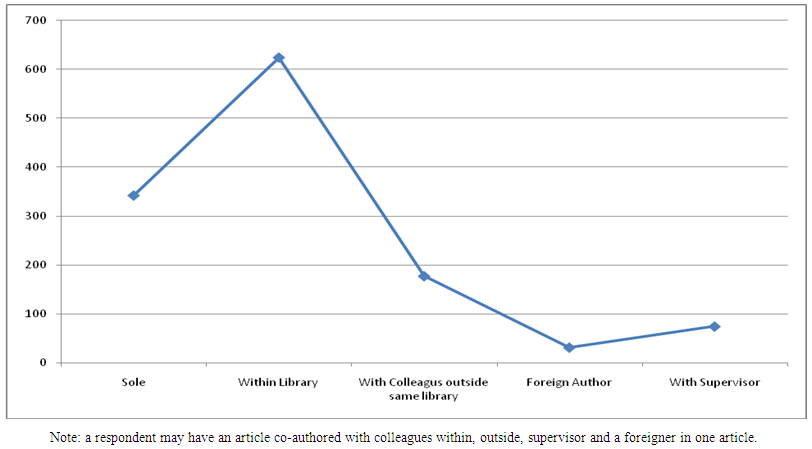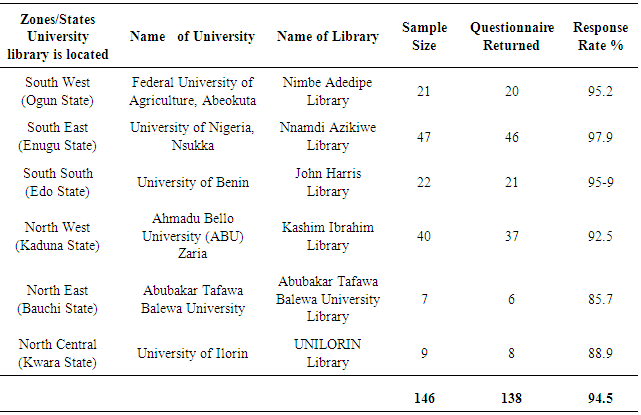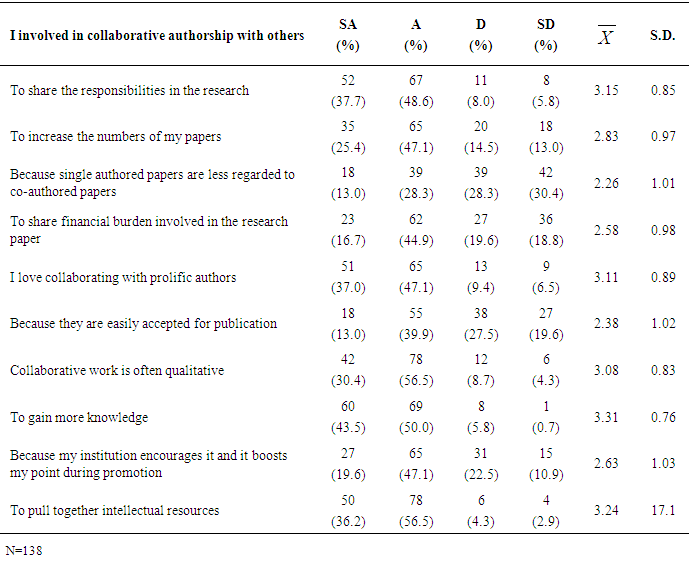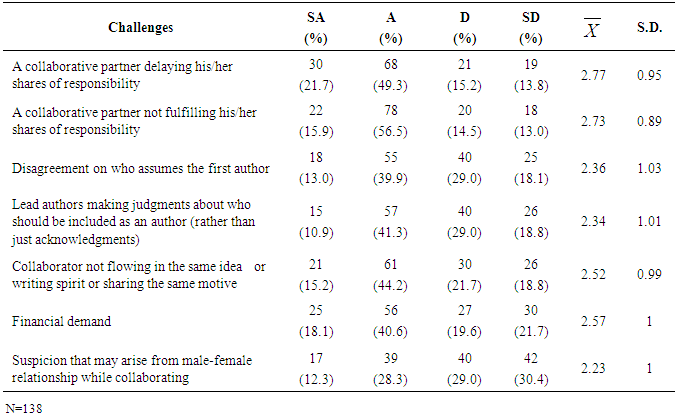-
Paper Information
- Paper Submission
-
Journal Information
- About This Journal
- Editorial Board
- Current Issue
- Archive
- Author Guidelines
- Contact Us
International Journal of Library Science
p-ISSN: 2168-488X e-ISSN: 2168-4901
2017; 6(1): 9-17
doi:10.5923/j.library.20170601.02

Collaborative Authorship among Academic Librarians from Federal University Libraries in Nigeria
Sarah I. Adegbaye 1, Rifqah O. Okunlaya 1, Blessing Chika Funom 2, Chinyere Amalahu 3
1Nimbe Adedipe Library, Federal University of Agriculture, Abeokuta, Nigeria
2University of Abuja Library, Abuja, Nigeria
3Tai Solarin University of Education Library
Correspondence to: Sarah I. Adegbaye , Nimbe Adedipe Library, Federal University of Agriculture, Abeokuta, Nigeria.
| Email: |  |
Copyright © 2017 Scientific & Academic Publishing. All Rights Reserved.
This work is licensed under the Creative Commons Attribution International License (CC BY).
http://creativecommons.org/licenses/by/4.0/

This paper presents a study of collaborative authorship among academic librarians across federal universities in Nigeria and the challenges authors face when engaging in joint writing of a paper/ article. This study is based on self-reported data from the respondents through a survey questionnaire. Librarians from six (6) federal university libraries of the six (6) geopolitical zones in Nigeria were studied. The multi-stage sampling method was used to select the six (6) universities. 138 academic librarians participated in the study out of 146 librarians working in the six federal university libraries selected, giving the response rate of 94.5%. Results revealed that the average degree of author collaboration of academic librarians is 0.73, which clearly indicates its dominance over single-authored contributions. It also revealed that academic librarians have more of co-authored papers than single ones. Academic librarians collaborate more with their colleagues within the same library. Of the 10 reasons indicated by librarians for involving in collaborative authorship, gaining more knowledge ranked highest. The challenges faced by librarians while collaborating with colleagues were not different from those identified in previous studies. Recommendations were proffered upon findings.
Keywords: Authorship, Co-authorship, Collaborative authorship, Degree of collaboration, Collaboration, Federal universities, Academic librarians
Cite this paper: Sarah I. Adegbaye , Rifqah O. Okunlaya , Blessing Chika Funom , Chinyere Amalahu , Collaborative Authorship among Academic Librarians from Federal University Libraries in Nigeria, International Journal of Library Science, Vol. 6 No. 1, 2017, pp. 9-17. doi: 10.5923/j.library.20170601.02.
Article Outline
1. Introduction
- Librarians in Nigerian university libraries were officially accorded academic status via a circular issued by the National University Commission (NUC) in 1993 (NUC, 1993). In other to justify the academic status accorded librarians, librarians are required to author publications as a prerequisite for promotion and appointment, in the same way as their teaching counterparts. Authorship of publication however, is a reward of hard work and a prime academic currency for the future career of academic librarians, especially in a university setting. Authorship has often been the sole basis for the academic advancement of librarians, as [15] had rightly put it, authorship is the coin of the realm in academia. Authorship is a compass that dictates the course and success of a librarian’s career and confers enormous responsibility. In university settings today, collaborative authorship whether within the same institution or outside institutions within the same country or outside is understood to be tremendously valuable and highly regarded, as it amalgamates skills, knowledge and resources, allows division of labour and the study of more difficult problems, including interdisciplinary ones. It also brings recognition and visibility and increases the network of contacts of the researchers involved. Co-authorship is an end result of various progressions of intellectual exchanges that facilitate the acquisition of skills undertaken within a community of facts and ideas. Despite the limitation of co-authorship measures, many studies have used this technique to investigate collaboration [13, 10]. In some instances, not all the names appearing in a paper are actually responsible for the work and should, therefore, have not shared the credit. This kind of co-authorship is what [10] refers to as conferment of honourary or gift co-authors. It means granting authorship because of authority, prestige, courtesy or out of respect or appreciation for an individual. Some authors do this to increase the likelihood of publication, credibility, or status of the work. Looking at this from another dimension, the reasons for including an undeserved co-author, as pointed out by [19] are pressure to publish, sense of obligation, fear of offending someone, pressure from another co-author, or explicit demand-all in hopes of reciprocation, or gaining favour. The degree of collaboration among academic librarians refers to the ratio of the number of collaborative published papers to the total number of research paper published in Library and Information Science (LIS) journals during a certain period of time. An academic librarian is any person who is skilled in the practice of librarianship profession, having acquired the skills through extensive educational training with the objective of obtaining a minimum of a masters’ degree in library and information science or equivalent [1]. The issue of collaborative authorship among librarians is an important one. As collaboration between grown significantly in recent decades, there has been more impetus for librarians to work together on research and authorship, and this has had impact on the identity and status of librarians. Therefore the subject of this paper is timely and important. The fact that this study focuses on Nigeria federal universities adds to the existing body of literature on the topic; the authors are providing a focus that has not yet been studied in the literature. Consequent upon this, this study is set to investigate the extent of collaboration among academic librarians; find out the pattern of authorship among the librarians, reason librarians involve in collaboration and the challenges they face while collaborating.
2. Research Questions
- 1. What is the degree of collaborative authorship among academic librarians? 2. Do librarians collaborate within, outside their institutions and with foreign authors?3. Why do academic librarians involve in collaborative authorship?4. What are the challenges of collaborative authorship?
3. Literature Review
- Collaborative authorship is a combination of two constructs ‘collaboration’ and ‘authorship’. [13] defined research collaboration as a system of research activities by several factors related in a functional and coordinated way to attain a research goal corresponding with these actors’ research goals or interests’. Research collaboration thus is working together of researchers to achieve the common goal of producing new scientific knowledge [8], which sometimes end up in co-authored publications. Authorship on the other hand, means playing a fundamental role in the creation of the product (article or publication) to be published [15]. [17] sees collaborative authorship as the act whereby two or more researchers agree to execute a certain project, be it intellectual or non-intellectual. Collaborative authorship is sometimes called co-authorship, co-shared authorship or as multiple authorship. It is the activities involved in the production of a paper or article by more than one author. [14] refers to multiple-authorship, as publications by two or more named persons. Though, not all collaborations lead to co-authorship of a publication. Some collaborations end up as sub-authors [17]. Sub-authors are those who are not co-authors, but whose theoretical or technical assistance in the research work is acknowledged by the author(s) in a publication. For the sake of the present study, co-authorship and collaborative authorship will be used interchangeably. [19] averred that co-authorship implies shared responsibility for the contents of the paper and that all persons designated as authors should qualify for authorship, and all those who qualify should be listed. He further stated that each author should have participated sufficiently in the work to take public responsibility for appropriate portions of the content and one or more authors should take responsibility for the integrity of the work as a whole, from inception to the published article. Aside that, the collaborators must come to an agreement, as to who will be the chief author of the publication output. Several earlier studies examined collaborative relationships among LIS authors following an underlying assumption that collaborative activity increases publications of academics [2, 20].Two major kinds of authorship collaboration among academic librarians which relate to this present study have been identified. These two major kinds of authorship collaboration were among the six kinds of collaboration pointed out by [17]. They are- a) Collaboration among colleagues and b) Teacher-pupil collaboration a). Collaboration among colleagues: Two or more academic librarians either a senior or junior colleague can work on a research study, with each contributing their intellectual quota for the effective success of the work. A colleague can co-author an article with another colleague within the same institution, he/she can as well co-author an article with a colleague at another institution or even with a professional colleague outside the shores of the country (International collaboration). It is possible that one article has these three relationships (i.e. co-authored with colleagues within the institution, colleagues outside the institution and with foreign colleagues). b). Teacher-pupil (supervisor-student): this kind of collaboration is a common mode of collaboration in an academic setting. It takes the form of postdoctoral or postgraduate student and others, who have worked under the supervision of a professor or a doctor and most of their clusters represent such research group. The output of the research in the form of journal articles and conference papers usually carries the name of both supervisor and the student. Years after graduation the supervisor can still maintains such co-authorship relationship with the student especially, if the student’s research skills are outstanding.There are varying factors that can contribute to collaboration in a research activity. Collaboration can come in different forms ranging from the rendering of advice and insights to active participation in a specific piece of research [10]. These collaborative contributions do vary in level from the very noteworthy to the almost negligible. Sometimes a collaborator is being listed as a co-author merely by virtue of providing material or performing a routine essay. In other instances, researchers from different institution may collaborate by sharing data or ideas through correspondence and communication or discussions at conferences and workshops, by performing part of the paper article separately and then integrating the results. There is this practice of collaboration, though not accepted as a co-authorship standard or policy, but it is a rampant practice of collaboration found among academic librarians today. An author single-handedly writes a paper and adds a colleague’s name, the former will, in turn, return the gesture by including that colleague’s name in his/her own work too. In total, the publications of both authors increased by one, this is what [16] refers to as “Mutual support” authorship. This practice, however, may have heightened due to the ever increasing pressure of "publish or perish", an academic cliché of which academic librarians are not exempted. And this urgent need for publications according to [3], has also led to abuses in authorship.[10] identified so many factors that can account for the increase in multiple-authored papers. These include: The desire of researchers to increase their visibility, popularity and recognition; increasing specialization in the fields of librarianship and information science; the requirement for more knowledge in order to make significant advances, a demand which often can only be met by pooling one’s knowledge with others; the need to gain experience or train neophyte researchers in the most effective way possible; increasing desire to obtain cross-fertilisation across related LIS (Library and Information Science) field; and the need to work in close proximity with others, in order to benefit from their skills and tacit knowledge.The benefits of collaborative authorship include and not limited to, the following: Collaborative authorship improves the quality of a written work by bringing together people with complementary areas of expertise. Through collaborative authorship, it is possible for partners to enhance each other’s writing. Co-authorship with a more experienced researcher facilitates the development of writing skills and builds confidence in collaborator(s) [4]. The synergic effect of co-authoring can be so remarkable, especially when both collaborators have writing chemistry, as a result it will be very easy to flow. A study by [9] revealed that jointly produced work was more often found to be of excellent quality by peer reviewers than work performed by a single author; collaborative authorship enhances productivity in terms of publications; through collaborative authoring, a neophyte researcher can be closely mentored by experienced researcher/author; collaborative authorship demonstrates the ability to work with others (i.e. the spirit of collegiality). Seeing co-authored work in curriculum vitae, indicates to a hiring or promotion committee that an applicant has involved him/herself in research with peers, whether within the same institution or outside; collaborative authorship alleviates the professional isolation in the career life of academic librarians, especially, collaboration outside one’s university.As discussed above, co-authorship offers a lot of advantages, however, there are some challenges faced by authors involved in collaboration. This includes: a) Collaborators may sincerely want to participate, but due to one commitment or matters beyond their control they may not contribute in a timely fashion. Such exhibition of impassiveness on the part of some co-authors can decrease the enthusiasm for future collaboration with such collaborator(s).b) Unscrupulous senior co-authors resort to subterfuge to take over the first authorship, which is accorded a special place, simply because he wants accolade [12].c) Disagreement with co-authors view, content and /or word choice. This happens in the revision process either before the submission or in responses to reviewers’ comment [5, 18].d) Lead authors making judgments about who should be included as an author (rather than just in the acknowledgments) for instance, turning a paper that is meant for A and B into A et al (and others) without the consent of the other collaborator [18]. e) Submitting paper without the consent of the others. This trend in co-authorship is very worrisome, as it is against the policy/or ethics of authorship publishing [12].
4. Methodology
- This study employs the descriptive research method. The population for this study consists of academic librarians in federal universities in Nigeria. Nigeria is made up of six geopolitical zones namely: North-West, North-East, North-Central, South-South, South-East, and South-West (see Fig. 1). The study adopted a multi-stage sampling procedure. First, the universities were grouped according to the existing six geopolitical zones in Nigeria. Secondly, one university was randomly selected from each of the six geopolitical zones. This, however, resulted in the selection of six (6) universities. The questionnaire was distributed to all 146 academic librarians in these six university libraries, however, the researchers were able to retrieve 138 copies back from the respondents, given the response rate of 94.5% (see table 1). A self-reported productivity measure derived from survey questionnaire was used to capture journal publications and authorship collaboration of librarians under study. Although, bibliometric study has been a technique used by several authors to capture collaborative authorship. The rationale behind the use of survey questionnaire for this present study is that Nigeria is a developing country, and the publications of authors are not well represented in international publication databases, especially, our local journals. To justify this approach, [22] noted that although bibliometric techniques result in generally valid and reliable estimates of productivity, they prove inadequate in studying scientific activity in developing countries, he further stressed that self-reported productivity is a more valid and reliable measure of output in the context of research institutions in developing countries. In order to calculate the degree of collaboration, Subramanyan’s (1983) formula was adopted. The data collected were tabulated, analyzed and discussed.
 | Figure 1. Map of Nigeria showing the six geopolitical zones that constituted the study area. (Source: www.nigerianmuse.com) |
|
5. Results
- Degree of collaborative authorship among academic librariansTo determine the degree of collaboration among academic librarians, the formula of Subramanyam (1983) has been adopted and modified.
 Where,C = Degree of collaborative authorship among librariansNm = Number of multiple- authored research papers in LIS journals between (2010-2015)N = Number of single–authored research papers in LIS journals between (2010-2015)
Where,C = Degree of collaborative authorship among librariansNm = Number of multiple- authored research papers in LIS journals between (2010-2015)N = Number of single–authored research papers in LIS journals between (2010-2015) Based on the formula calculated above, the average degree of author collaboration among librarians is 0.73, which clearly indicates its prevalence over single authored contributions. This implies that academic librarians collaborate on their publications. Co-authorship among academic librarians In respect to whom academic librarians co-author their papers with, respondents were asked to indicate how many papers they have co-authored with colleagues within their institution or library, outside their library, with supervisor and with foreign authors. The result, however, shows that 342 papers were solely authored by the sampled librarians, 624 were papers written with colleagues within the library, 177 were papers written with colleagues outside the library and 31 were papers written with foreign colleagues, while 74 were papers authored with supervisors. This also means that one article can be co-authored with colleagues from within, outside their library, supervisor and foreigners. A look at Figure 2 shows that co-authorship was high with colleagues within the library probably because of the closeness and other important factors, while papers co-authored with colleagues that are foreigners were at low ebb probably because of distance and other important factors. Co-authored papers with supervisors were also found to be low.
Based on the formula calculated above, the average degree of author collaboration among librarians is 0.73, which clearly indicates its prevalence over single authored contributions. This implies that academic librarians collaborate on their publications. Co-authorship among academic librarians In respect to whom academic librarians co-author their papers with, respondents were asked to indicate how many papers they have co-authored with colleagues within their institution or library, outside their library, with supervisor and with foreign authors. The result, however, shows that 342 papers were solely authored by the sampled librarians, 624 were papers written with colleagues within the library, 177 were papers written with colleagues outside the library and 31 were papers written with foreign colleagues, while 74 were papers authored with supervisors. This also means that one article can be co-authored with colleagues from within, outside their library, supervisor and foreigners. A look at Figure 2 shows that co-authorship was high with colleagues within the library probably because of the closeness and other important factors, while papers co-authored with colleagues that are foreigners were at low ebb probably because of distance and other important factors. Co-authored papers with supervisors were also found to be low.  | Figure 2. Co-authorship among academic librarians |
 =3.15). Moreover, 72.5% of the respondents indicated that they involve in collaborative authorship to increase the numbers of their papers (
=3.15). Moreover, 72.5% of the respondents indicated that they involve in collaborative authorship to increase the numbers of their papers ( =2.83). Furthermore, 41.3% of the respondents involved in collaborative authorship because single authored papers are less regarded to co-authored papers (
=2.83). Furthermore, 41.3% of the respondents involved in collaborative authorship because single authored papers are less regarded to co-authored papers ( =2.26). In addition, 61.6% respondents involve in collaborative authorship to share financial burden involved in the research paper (
=2.26). In addition, 61.6% respondents involve in collaborative authorship to share financial burden involved in the research paper ( =2.58). Consequently, 84.1% of the respondents love collaborating with prolific authors (
=2.58). Consequently, 84.1% of the respondents love collaborating with prolific authors ( =3.11). 51.9% respondents involve in collaborative authorship because they are easily accepted for publication (
=3.11). 51.9% respondents involve in collaborative authorship because they are easily accepted for publication ( =2.38). Also, 86.9% were of the opinion that collaborative work is often qualitative (
=2.38). Also, 86.9% were of the opinion that collaborative work is often qualitative ( =3.08). Moreso, 93.5% of the librarians agreed that they gain more knowledge when they collaborate with other authors (
=3.08). Moreso, 93.5% of the librarians agreed that they gain more knowledge when they collaborate with other authors ( =3.31). In addition, 66.7% of the librarian sampled agreed that they collaborate with colleagues because their institution encourages it and it boosts their point during promotion (
=3.31). In addition, 66.7% of the librarian sampled agreed that they collaborate with colleagues because their institution encourages it and it boosts their point during promotion ( =2.63). Lastly, 92.7% of the respondents indicated that they collaborate with colleagues to pull together their intellectual resources (
=2.63). Lastly, 92.7% of the respondents indicated that they collaborate with colleagues to pull together their intellectual resources ( =3.24).
=3.24).
|
 =2.77). However, a similar proportion 72.4% of respondents agreed that they face the challenge of a collaborative partner not fulfilling his/her shares of responsibility (
=2.77). However, a similar proportion 72.4% of respondents agreed that they face the challenge of a collaborative partner not fulfilling his/her shares of responsibility ( =2.73). 52.9% of the respondents agreed that they face challenge of disagreement on who assumes the first author (
=2.73). 52.9% of the respondents agreed that they face challenge of disagreement on who assumes the first author ( =2.36), 52.2% of them also agreed to the statement that lead authors making judgments about who should be included as an author (rather than just in acknowledgements) (
=2.36), 52.2% of them also agreed to the statement that lead authors making judgments about who should be included as an author (rather than just in acknowledgements) ( =2.34), 59.4% collaborator not flowing in the same idea or writing spirit or sharing the same motive (
=2.34), 59.4% collaborator not flowing in the same idea or writing spirit or sharing the same motive ( =2.52), 58.7% of the respondent agreed that financial demand is a challenge they face while collaborating (
=2.52), 58.7% of the respondent agreed that financial demand is a challenge they face while collaborating ( =2.57), and less than one –third 40.6% of the respondents agreed that they face the challenge of the suspicion that may arise from male-female relationship while collaborating (
=2.57), and less than one –third 40.6% of the respondents agreed that they face the challenge of the suspicion that may arise from male-female relationship while collaborating ( =2.23).
=2.23).
|
6. Discussion
- The study found out the pattern of authorship collaboration among academic librarians in federal universities in Nigeria, using the samples from universities in the country’s six geopolitical zones. The findings of this study revealed that the degree of collaboration is 0.73, this implies that published papers are predominated by co-authored ones. This corroborates the findings of [11] and [21], who from their different studies discovered that multi-authored articles are higher and predominant on single-authored papers.The result shows that academic librarians prefer to collaborate more with their colleagues within the same institution or the same library. The reason for this may be as a result of closeness. It is very easy to work together as co-authors when they are working in the same environment. Next to this, are the papers co-authored with colleagues outside the institution or in other libraries. This type of collaborative authorship relationship may arise from attendance at workshops, conferences, and seminars. Others may be as a result of their former place of work or educational institutions attended. Collaboration in such manner does not stop even when the librarian is no longer working in that institution. Another type of collaboration as revealed in this study is co-authoring with supervisors. Masters’ and PhD students still maintain co-authorship relationship with their supervisors even years after graduation, though in this study, papers with supervisors are less than two-third of the multiple-authored papers. The least of them are co-authored papers with foreign colleagues. Distance may probably be the reason why academic librarians have very few or no papers co-authored with foreign colleagues. [6] found that geographical proximity plays a significant role in collaboration. They added that the greater the geographical distance the greater is the impediment to collaboration. This study revealed several reasons why academic librarians collaborate. The most prevalent reason indicated by librarians for collaborating is the pulling together of their intellectual resources. Co-authoring a paper with an experienced colleague facilitates the quality of the paper, it pulls together expertise and skills. This finding, however, confirms the study of [9] which reveals that jointly produced work was more often found to be of excellent quality by peer reviewers than works undertaken by single authors. This, however, is possible because they have pulled together their intellectual resources. Another reason for collaboration as indicated by librarians is that they gain more knowledge when they collaborate with other authors. Through collaboration neophyte researchers can be closely mentored by more experienced researchers/authors, by so doing they gain more knowledge and improve their research skill. Another advantage of collaborating with other authors is the greater chance of increasing their publications quantitatively. The reason is heightened by the current practice of co-authorship, where names are included in a paper that is single handedly written by one person, in return the person includes the name of the former in his/her paper, making it two papers for both authors. Librarians co-author papers because the institutions encourage co-authorships, by way of scoring co-authored papers higher, especially for the first author. Most journal outlets charge an exorbitant fee to publish a paper. To lessen the financial burden, an author prefers to co-author the paper with two or more authors. Furthermore, librarians collaborate because co-authored papers are easily accepted for publishing. Giving the increasing random component associated with peer review, co-authoring reduces the risk of rejection of a manuscript. Lastly, librarians co-authored papers because single-authored papers are less regarded than co-authored ones. The findings of this study reveal the challenges faced by academic librarians when collaborating. The most prevalent challenge was collaborative partners not fulfilling his/her share of responsibilities. Often times, a collaborative partner for one reason or another delay his/her share of research responsibilities, thereby making one author to be waiting for the co-author to send his or her part of the research work, this in turn, will slow down the completion of the paper. This explains the reasons why a paper takes one year or more to get published. Sometimes it leads to the abandonment of the paper. It is revealed in this study also that librarians do face the challenge of who assumes the first author when the paper is finally completed. Collaborators not flowing in the same idea or writing spirit, or wrongly assuming that you have the same idea as your co-author on the writing approach, are another challenge faced by librarians and this may also slow down the research work. The least of these challenges as revealed in this study is the suspicion that may arise from male-female relationship while collaborating.
7. Conclusion and Recommendations
- This study has been able to establish the fact that academic librarians in federal universities in Nigeria have more of co-authored papers than single authored ones. It was also glaring from the findings that they co-author more with colleagues within the same library/institution than those outside the institution and outside Nigeria (foreign colleagues). The authors assume it to be as a result of distance, but it is expected that with the internet, distance won’t be a barrier of collaborating with colleagues outside the country. Despite the advantages of collaborative authorship, it was not without challenges, of course, these challenges were not different from the ones identified in previous studies reviewed in this paper. Challenges like a collaborative partner not fulfilling or delaying his/her shares of responsibility among others indicated in this study are very common with collaborative authorship. Librarians should ensure that they don’t collaborate only with colleagues of their immediate workplace, however, they should extend their collaborating network to colleagues outside their institution and outside the country (foreign colleagues) as this will boost their professional visibility. For effective author collaboration with professional colleagues outside their institutions, librarians should take full advantage of the variety of co-authoring tools made possible by information technologies like google docs, Microsoft onedrive, email, skype, dropbox, etc. Attendance of international conferences would also help to facilitate co-authoring with foreign colleagues.
 Abstract
Abstract Reference
Reference Full-Text PDF
Full-Text PDF Full-text HTML
Full-text HTML

